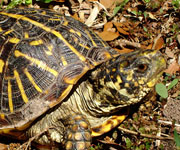
In every survival class I teach, somebody is usually surprised when we pass by a millipede or toad in the woods and I mention that, “You can’t eat that.” Based on the animal’s diet, or some inherent toxin in their bodies, they are not suitable for people to eat. But they aren’t the only things that are off the menu.
The box turtle, for example, is really a tortoise. Living on land, they encounter all kinds of deadly mushrooms that grow to just the right height for them to munch. Consuming these toxins, the box turtles’ flesh can become toxic as another deterrent to predators (when the shell just isn’t enough). Many years ago, this possibility was well known by indigenous peoples. A number of eastern native tribes and nations had taboos against eating these tortoises, and just to be on the safe side we should too.
Already mentioned, another non-edible critter is the toad. Some of those lumps and bumps on their back contain a bitter (or flat out toxic) secretion. If you’re not sure whether you have a frog or a toad, toads have a dry skin that is warty, frogs have a smooth or relatively smooth skin that is usually moist.
Millipedes and centipedes can be a problem to adventurous diners. These bugs, along with others that have eaten poisonous plants, can be dangerous to eat even if they are cooked. In the realm of bug food, and many other endeavors, the rule of thumb is to keep it simple. Worms, green or brown grass hoppers, crickets and wood grubs, when cooked, are reasonable choices for humans to eat. Flashy colors and questionable diets should serve as red flags to not eat a particular critter.
Purple- or blue-colored berries are another potentially dangerous food selection. While the majority of purple, blue or black berries in the world are harmless foods, we don’t need to take the risk of playing any kind of guessing game. Poke berries, nightshade and Virginia creeper are just a few of my local species that have claimed the lives of the unaware. Don’t ever eat a plant or berry without having a 100-percent positive identification of the plant, and the knowledge of how to consume it.
Did you ever get adventurous, and then get sick because of it? Don’t be shy, let us know in the comments.
Photo by Patrick Feller on Flickr.
